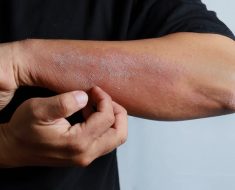Overweight and obesity, as well as their related chronic diseases, are largely preventable and at an individual level, people can achieve energy balance and a healthy weight by limiting energy intake from total fats and shifting fat consumption away from saturated fats to unsaturated fats – increasing their consumption of fruit and vegetables, as well as legumes, whole grains and nuts – limiting their intake of sugars and increasing physical activity.
Experts recommend at least 30 minutes of regular, moderate-intensity activity on most days – more activity may be required for weight control.
On a broader level governments and other stakeholders, by sustained commitment, can play a vital role in shaping healthy environments and making healthier diet options affordable and easily accessible. This is particularly important for the most vulnerable in society – the poor and children, who have limited choices about the food they eat and the environments in which they live.
The Good News!
The key to success is to achieve an energy balance between calories consumed and calories used up. Experts suspect that the risk of health problems starts when someone is only very slightly overweight, and that the likelihood of problems increases as someone becomes more and more overweight and many of these conditions cause long-term suffering for individuals and families and are costly for health systems.
Healthy diets and regular, adequate physical activity are major factors in the promotion and maintenance of good health throughout the entire life course and unhealthy diets and physical inactivity are two of the main risk factors for raised blood pressure, raised blood glucose, abnormal blood lipids, overweight/obesity, and for the major chronic diseases such as cardiovascular diseases, cancer, and diabetes.
Overall, 2.7 million deaths are attributable to low fruit and vegetable intake and 1.9 million deaths to physical inactivity – unhealthy diets and physical inactivity are major risk factors for chronic diseases.
Unhealthy diets and physical inactivity are two of the main modifiable risk factors for most of the main chronic diseases.
Physical Activity
Physical activity is defined as any bodily movement produced by skeletal muscles that requires energy expenditure and physical inactivity is an independent risk factor for chronic diseases, and overall is estimated to cause 1.9 million deaths globally. Physical activity is fundamental to energy balance and weight control – different types and amounts of physical activity are required for different health outcomes – at least 30 minutes of regular, moderate-intensity physical activity on most days is recommended by experts.
The Center for Disease Control and Prevention (CDC) says increasing physical activity is a societal, not just an individual problem and demands a population-based,multi-sectoral, multi-disciplinary, and culturally relevant approach.
The intensity of different forms of physical activity varies between people and the intensity of physical activity depends on an individuals previous exercise experience and their relative level of fitness.
Metabolic Equivalents (METs) are commonly used to express the intensity of physical activities. MET is the ratio of a person's working metabolic rate relative to their resting metabolic rate. One MET is defined as the energy cost of sitting quietly and is equivalent to a caloric consumption of 1kcal/kg/hour. It is estimated that compared with sitting quietly, a person's caloric consumption is three to six times higher when being moderately active (3-6 METs) and more than six times higher when being vigorously active (>6 METs).
Benefits of Physical Activity
Experts recommend that people throughout their lives engage in adequate levels of physical activity for the benefit of their health – more physical activity provides greater health benefits.
There is also evidence to suggest that increasing levels of various types of physical activity may benefit health through positive effects on hypertension, osteoporosis and falls risk, body weight and composition, musculoskeletal conditions such as osteoarthritis and low back pain and mental and psychological health by reducing depression, anxiety and stress.
Physical activity also helps control risky behaviours particularly among children and young people (e.g. tobacco use, alcohol / substance use, unhealthy diet and violence). Regular physical activity may also benefit communities and economies through increased productivity in the workplace, lower worker absenteeism and turnover and better performing schools.
A significant proportion of many health budgets is spent on managing common NCDs that are associated with inadequate physical activity and the promotion of physical activity can be a highly cost-effective and sustainable public health intervention.
Being physically active need not be expensive or involve equipment, special shoes and clothes and can be done almost anywhere. Many everyday activities and chores such as carrying groceries, wood, books or children are good complementary physical activities, as is climbing the stairs instead of using the elevator.
Walking is perhaps the most common and most highly recommended physical activity, is absolutely free and can be done in urban areas, parks and even in shopping centers. It is not essential to go to a gym, pool or other special sports facility to be physically active.
Thirty minutes of moderate-intensity physical activity five days each week will improve and maintain health and can be done in shorter blocks of 10 minutes each over the course of a day and incorporated into a daily routine – at work, school, home or play.
Simple changes such as using stairs instead of lifts, riding a bike to work or getting off the bus two stops before your final destination and then walking the rest of the way can accumulate over the day and can form part of a regular daily activity programme. Even the busiest people should be able to fit 30 minutes of physical activity into their daily routine to improve their health.
Physical Activity and Children
 |
School-aged youth should accumulate at least 60 minutes of moderate- to vigorous-intensity physical activity each day to ensure healthy development but experts say less than one-third of young people are sufficiently active to benefit their present and future health and well-being. This decline in physical activity is largely due to increasingly common sedentary ways of life – fewer children walk or cycle to school and excessive time is devoted to watching television, playing computer games, and using computers – often at the expense of time and opportunities for physical activity and sports – added to this is the decrease in physical education and other school-based physical activities.
Patterns of physical activity and healthy lifestyles acquired during childhood and adolescence are more likely to be maintained throughout the life-span and improving physical activity levels in young people is imperative for the future health of all populations. Regular physical activity has been shown to improve the functional status and quality of life of older adults and also improves mental health and cognitive function .
Active lifestyles often provide older persons with regular occasions to make new friendships, maintain social networks, and interact with other people of all ages and to contribute to the management of disorders such as depression Physical activity helps young people to develop healthy musculoskeletal tissues (i.e. bones, muscles and joints), a healthy cardiovascular system (i.e. heart and lungs), coordination and movement control, maintain a healthy body weight.
Physical activity has also been associated with psychological benefits in young people by improving their control over anxiety and depression and providing opportunities for self-expression, building self-confidence, social interaction and integration.
While being active from an early age can help prevent many diseases, regular movement and activity can also help relieve the disability and pain associated with these conditions. Importantly, the benefits of physical activity can be enjoyed even if regular practice starts late in life.
At least 60% of the world's population fails to meet the recommendations for physical activity required to induce health benefits and NCDs associated with physical inactivity are the greatest public health problem in most countries around the world – levels of inactivity are high in virtually all developed and developing countries.
Physical Activity and Women
 Social inequality, poverty and inequitable access to resources, including health care, result in a high burden of noncommunicable diseases (NCDs) among women worldwide and though women generally tend to live longer with NCDs than men, they are often in poor health.
Social inequality, poverty and inequitable access to resources, including health care, result in a high burden of noncommunicable diseases (NCDs) among women worldwide and though women generally tend to live longer with NCDs than men, they are often in poor health.
Regular physical activity can improve women's health and help prevent many of the diseases and conditions that are major causes of death and disability for women around the world such as cardiovascular diseases which accounts for one-third of deaths among women around the world and half of all deaths in women over 50 years old in developing countries and diabetes which affects more than 70 million women in the world and its prevalence is projected to double by 2025.
Osteoporosis is a disease in which bones become fragile and more likely to break and is Physical Activity has also been associated with improved psychological health by reducing levels of stress, anxiety and depression which is particularly important for women who are twice as likely as men to develop these conditions.
It has also been suggested that physical activity can contribute to building self-esteem and confidence and can provide a vehicle for social integration and equality for women in society.
Many factors hinder the participation of women in physical activity and their access to health care – their income is often lower than that of men and therefore the costs of access to physical activity facilities may be a barrier – senior members of the household who control household resources may have to agree before a woman can engage in physical activity – also women often have a workload in the home and care-giving roles for other family members which may limit the time available for them to engage in physical activity – women who have limited mobility may be unable to travel to health centres.
Physical activity may also be restricted by cultural expectations and women in rural and in low income urban areas women may also be already physically exhausted by other forms of day-long "occupational" physical activities.
Physical Activity and Seniors
Regular physical activity has been shown to improve the functional status and quality of life of older adults and experts recommend that, if appropriate, older adults should engage in at least 30 minutes of moderate-intensity physical activity 5 days per week.
Many noncommunicable diseases (NCDs) prevalent in older adults can benefit from participation in regular physical activity – while being active from an early age can help prevent many diseases, regular movement and activity can also help relieve the disability and pain associated with these conditions. Importantly, the benefits of physical activity can be enjoyed even if regular practice starts late in life. Older adults engaged in regular physical activity have shown improved balance, strength, coordination and motor control flexibility endurance – regular physical activity can reduce the risk of falls – a major cause of disability among older people, and improve their mental health and cognitive function.
It has also been found to contribute to the management of disorders such as depression and anxiety – active lifestyles often provide older persons with regular occasions to make new friendships, maintain social networks, and interact with other people of all ages.
Physical activity for older adults can take many forms (e.g. walking, swimming, stretching, dancing, gardening, hiking, cycling or organised exercise sessions). However, there are several important considerations specific to the older adult population with regard to physical activity recommendations: aerobic activity should take into account the older adult's aerobic fitness – activities that maintain or increase flexibility are recommended as are balance exercises for those at risk of falls and medical conditions or disabilities that may affect their capacity must be considered.
The number of people over 60 years old is projected to double in the next 20 years and most will be living in developing countries so reducing and postponing age-related disability is an essential public health measure and physical activity can play an important role in creating and sustaining well-being at all ages.
Health gains worldwide would be achieved if the food industry seized the initiative and reduced the fat, sugar and salt content of processed foods and portion sizes and increased the introduction and marketing of innovative, healthy, and nutritious choices.
The WHO Global Strategy on Diet, Physical Activity and Health called on all stakeholders to take action at global, regional and local levels in order to reduce the prevalence of chronic diseases and their common risk factors, primarily unhealthy diet and physical inactivity.
WHO's work on diet and physical activity is part of the overall WHO chronic disease prevention and control framework of the Department of Chronic Diseases and Health Promotion. The strategic objectives of the department are to: advocate for health promotion and chronic disease prevention and control; promote health, especially for poor and disadvantaged populations; slow and reverse the adverse trends in the common chronic disease risk factors; and prevent premature deaths and avoidable disability due to major chronic diseases.
This work is complemented by that of the Department of Nutrition for Health and Development. The strategic objectives of the department are to promote healthy diets and improve the nutritional status of the population throughout the life course, particularly among the vulnerable. This is achieved by providing support to countries in developing and implementing national intersectoral Food and Nutrition Policies and Programmes to address double-burden of nutrition-related ill-health, and to contribute to the achievement of the Millennium Development Goals (MDGs).
Further Reading
- All Obesity Content
- What is Obesity?
- Causes of Obesity and Overweight
- What is Body Mass Index (BMI)?
- Obesity and Fast Food
Last Updated: Feb 27, 2019
Source: Read Full Article





